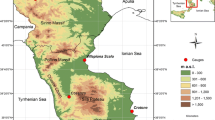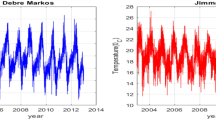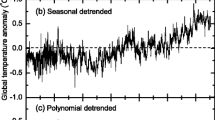Abstract
This paper introduces a new temperature index, which can suitably represent the underlying of a weather derivative. Such an index is defined as the weighted mean of daily average temperatures measured in different locations. It may be used to hedge volumetric risk, that is the effect of unexpected fluctuations in the demand/supply for some specific commodities—of agricultural or energy type, for example—due to unfavorable temperature conditions. We aim at exploring the long term memory property of the volatility of such an index, in order to assess whether there exist some long-run paths and regularities in its riskiness. The theoretical part of the paper proceeds in a stepwise form: first, the daily average temperatures are modeled through autoregressive dynamics with seasonality in mean and volatility; second, the assessment of the distributional hypotheses on the parameters of the model is carried out for analyzing the long term memory property of the volatility of the index. The theoretical results suggest that the single terms of the index drive the long memory of the overall aggregation; moreover, interestingly, the proper selection of the parameters of the model might lead both to cases of persistence and antipersistence. The applied part of the paper provides some insights on the behaviour of the volatility of the proposed index, which is built starting from single daily average temperature time series.




Similar content being viewed by others
References
Alexandridis, A., & Zapranis, A. D. (2013). Weather derivatives: Modeling and pricing weather-related risk. Berlin: Springer.
Ausloos, M., & Ivanova, K. (1999). Low q-moment multifractal analysis of gold price, Dow Jones Industrial Average and BGL-USD exchange rate. European Physical Journal B, 8, 665–669.
Ausloos, M., & Ivanova, K. (2000). Introducing false EUR and false EUR exchange rates. Physica A, 286, 353–366.
Benth, F. E. (2003). On arbitrage-free pricing of weather derivatives based on fractional Brownian motion. Applied Mathematical Finance, 10, 303–324.
Benth, F. E., & Saltyte Benth, J. (2013). Modeling and pricing in financial markets for weather derivatives. Singapore: World Scientific.
Bianchi, S., Pantanella, A., & Pianese, A. (2013). Modeling stock prices by multifractional Brownian motion: An improved estimation of the pointwise regularity. Quantitative Finance, 13, 1317–1330.
Bloch, D., Annan, J., & Bowles, J. (2011). Applying climate derivatives to flood risk management. Wilmott, 2011(56), 88–103.
Bollerslev, T. (1986). Generalized autoregressive conditional heteroskedasticity. Journal of Econometrics, 31, 307–327.
Bollerslev, T., & Mikkelsen, H. O. (1996). Modelling and pricing long memory in stock market volatility. Journal of Econometrics, 73, 151–184.
Bouchaud, J. P., Gefen, Y., Potters, M., & Wyart, M. (2004). Fluctuations and response in financial markets: The subtle nature of random price changes. Quantitative Finance, 4(2), 176–190.
Brock, W. A., & Hommes, C. H. (1997). Rational route to randomness. Econometrica, 65, 1059–1095.
Brock, W. A., & Hommes, C. H. (1998). Heterogeneous beliefs and routes to chaos in a simple asset pricing model. Journal of Economic Dynamics & Control, 22, 1235–1274.
Brody, C. D., Syroka, J., & Zervos, M. (2002). Dynamical pricing of weather derivatives. Quantitave Finance, 2, 189–198.
Bunn, D. W., & Oliveira, F. S. (2003). Evaluating individual market power in electricity markets via agent-based simulation. Annals of Operations Research, 121(1–4), 57–77.
Campbell, S. D., & Diebold, F. X. (2005). Weather forecasting for weather derivatives. Journal of the American Statistical Association, 100, 6–16.
Cao, M., Li, A., & Wei, J. Z. (2004). Watching the weather report. Canadian Investment Review, 17, 27–33.
Cao, M., & Wei, J. Z. (2004). Weather derivatives valuation and market price of weather risk. Journal of Futures Markets, 24, 1065–1089.
Cerqueti, R., & Rotundo, G. (2012). The role of diversity in persistence aggregation. International Journal of Intelligent Systems, 27, 176–187.
Cerqueti, R., & Rotundo, G. (2015). A review of aggregation techniques for agent-based models: Understanding the presence of long-term memory. Quality & Quantity, 49, 1693–1717.
Cheung, Y. W., & Lai, K. S. (1993). A fractional cointegration analysis of purchasing power parity. Journal of Business and Economic Statistics, 11, 103–112.
Davis, M. (2001). Pricing weather derivatives by marginal value. Quantitative Finance, 1, 305–308.
Ding, Z., & Granger, C. W. J. (1996). Modeling volatility persistence of speculative returns: A new approach. Journal of Econometrics, 73, 185–215.
Dorfleitner, G., & Wimmer, M. (2010). The pricing of temperature futures at the Chicago Mercantile Exchange. Journal of Banking & Finance, 34, 1360–1370.
Eliazar, I., & Klafter, J. (2005). On the nonlinear modeling of shot noise. Proceedings of the National Academy of Sciences of the United States of America, 102(39), 13779–13782.
Engle, R. F. (1982). Autoregressive conditional heteroscedasticity with estimates of the variance of United Kingdom inflation. Econometrica, 50, 987–1007.
Foellmer, H., Horst, U., & Kirman, A. (2005). Equilibria in financial markets with heterogeneous agents: A probabilistic perspective. Journal of Mathematical Economics, 41, 123–155.
Franses, P. H., Neele, J., & van Dijk, D. (2001). Modeling asymmetric volatility in weekly Dutch temperature data. Environmental Modelling & Software, 16, 131–137.
Geman, H., & Leonardi, M. P. (2005). Alternative approaches to weather derivatives pricing. Managerial Finance, 31, 46–72.
Golden, L. L., Wang, M., & Yang, C. (2007). Handling weather related risks through the financial markets: Considerations of credit risk, basis risk, and hedging. Journal of Risk and Insurance, 74(2), 319–346.
Granger, C. W. J. (1980). Long memory relationships and the aggregation of dynamic models. Journal of Econometrics, 14, 227–228.
Gulpinar, N., & Canakoglu, E. (2017). Robust portfolio selection problem under temperature uncertainty. European Journal of Operational Research, 256(2), 500–523.
Hardle, W.K., & Osipenko, M. (2011). Spatial risk premium on weather derivatives and hedging weather exposure in electricity. SFB 649 discussion paper.
Hommes, C. H. (2001). Financial Markets as nonlinear adaptive evolutionary systems. Quantitative Finance, 1, 149–167.
Hurst, H. (1951). Long term storage capacity of reservoirs. Transactions of the American Society of Civil Engineers, 116, 770–799.
Hurst, H. E. (1957). A suggested statistical model of some time seris which occur in nature. Nature, 180, 494.
Ivanova, K., & Ausloos, M. (1999). Low-order variability diagrams for short-range correlation evidence in financial data: BGL-USD exchange rate, Dow Jones industrial average, gold ounce price. Physica A, 265, 279–291.
Lillo, F., Mike, S., & Farmer, J. D. (2005). Theory for long memory in supply and demand. Physical Review E, 71(6), 066122.
Little, M., McSharry, P., Moroz, I., & Roberts, S. (2006). Nonlinear, biophysically-informed speech pathology detectionin. In 2006 IEEE International Conference on Acoustics, Speech and Signal Processing. ICASSP 2006 Proceedings.: Toulouse, France. pp. II-1080-II-1083.
Lo, A. W. (1991). Long memory in stock market prices. Econometrica, 59, 1279–1313.
Lux, T., & Ausloos, M. (2002). Market fluctuations I: Scaling, multi-scaling and their possible origins. In A. Bunde, J. Kropp, & H.-J. Schellnhuber (Eds.), The science of disaster: Scaling laws governing weather, body, stock-market dynamics (pp. 377–413). Berlin: Springer.
Mandelbrot, B. B., & Wallis, J. (1968). Noah, Joseph and operational hydrology. Water Resources Research, 4, 909–918.
Markovich, N. M., & Kilpi, J. (2009). Bivariate statistical analysis of TCP-flow sizes and durations. Annals of Operations Research, 170(1), 199–216.
McLeod, A. I., & Hipel, A. W. (1978). Preservation of the rescaled adjusted range, 1: A reassessment of the Hurst phenomenon. Water Resources Research, 14, 491–508.
Müller, A., & Grandi, M. (2000). Weather derivatives: A risk management tool for weather-sensitive industries. Geneva papers on risk and insurance. Issues and Practice, 25(2), 273–287.
Rangarajan, G., & Ding, M. (2000). Integrated approach to the assessment of long range correlation in time series data. Physical Review E, 61(5), 4991–5001.
Reboredo, J. C., Rivera-Castro, M. A., Miranda, J. G. V., & García-Rubio, R. (2013). How fast do stock prices adjust to market efficiency? Evidence from a detrended fluctuation analysis. Physica A, 392, 1631–1637.
Saltyte Benth, J., Benth, F. E., & Jalinskas, P. (2007). A spatial-temporal model for temperature with seasonal variance. Journal of Applied Statistics, 34(7), 823–841.
Saltyte Benth, J., & Saltyte, L. (2011). Spatial-temporal model for wind speed in Lithuania. Journal of Applied Statistics, 38(6), 1151–1168.
Schiller, F., Seidler, G., & Wimmer, M. (2012). Temperature models for pricing weather derivatives. Quantitative Finance, 12, 489–500.
Smith, W., & Harris, C. M. (1987). Fractionally differenced models for water quality time series. Annals of Operations Research, 9(1), 399–420.
Stulec, I. (2017). Effectiveness of weather derivatives as a risk management tool in food retail: The case of Croatia. International Journal of Financial Studies, 5(1), 2.
Syroka, J. I., & Toumi, R. (2001). Scaling and persistence in observed and modelled surface temperature. Geophysical Research Letters, 28, 3255–3259.
Taylor, J. W., & Buizza, R. (2004). A comparison of temperature density forecasts from GARCH and atmospheric models. Journal of Forecasting, 23, 337–355.
Taylor, J. W., & Buizza, R. (2006). Density forecasting for weather derivative pricing. International Journal of Forecasting, 22, 29–42.
Tsonis, A. A., Roebber, P. J., & Elsner, J. B. (1999). Long-range correlations in the extratropical atmospheric circulation: Origins and implications. Journal of Climate, 12, 1534–1541.
Vandewalle, N., & Ausloos, M. (1998). Spareness and roughness of foreign exchange rates. International Journal of Modern Physics C, 9, 711–720.
Wei, A., & Leuthold, R.M. (2000). Agricultural futures prices and long memory processes. OFOR working paper no. 00.04. Available at SSRN: http://ssrn.com/abstract=229795 or https://doi.org/10.2139/ssrn.229795.
Weron, R. (2002). Estimating long-range dependence: Finite sample properties and confidence intervals. Physica A: Statistical Mechanics and its Applications, 312(1), 285–99.
Yang, C. C., Li, L. S., & Wen, M. M. (2011). Weather risk hedging in the European markets and international investment diversification. The Geneva Risk and Insurance Review, 36(1), 74–94.
Zaffaroni, P. (2007). Memory and aggregation for models of changing volatility. Journal of Econometrics, 136, 237–249.
Zambrano, C., & Olaya, Y. (2016). An agent-based simulation approach to congestion management for the Colombian electricity market. Annals of Operations Research. https://doi.org/10.1007/s10479-016-2222-4.
Zara, C. (2010). Weather derivatives in the wine industry. International Journal of Wine Business Research, 22(3), 222–237.
Zhao, Y., Chang, S., & Liu, C. (2015). Multifractal theory with its applications in data management. Annals of Operations Research, 234(1), 133–150.
Acknowledgements
The authors thank Dr. Ing. R. de Kok for fruitful management of data.
Author information
Authors and Affiliations
Corresponding author
Rights and permissions
About this article
Cite this article
Castellano, R., Cerqueti, R. & Rotundo, G. Exploring the financial risk of a temperature index: a fractional integrated approach. Ann Oper Res 284, 225–242 (2020). https://doi.org/10.1007/s10479-018-3063-0
Published:
Issue Date:
DOI: https://doi.org/10.1007/s10479-018-3063-0




